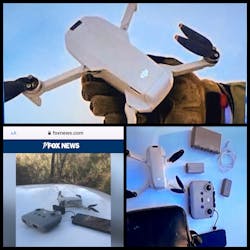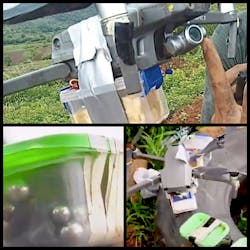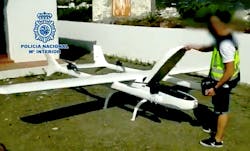While they serve their purposes, drones are becoming a bigger watchword than ever in the security industry, whether the threat comes from an inattentive or inexperienced pilot or involves something more sinister.
At Super Bowl LVII in Arizona, the U.S. Department of Homeland Security DHS established a “no drone zone” over the event sites due to concerns over airborne threats.
Never falling short on their ingenuity, Mexican drug cartels are joining the list of adversaries who security officials must be concerned about. Recently, a reporter on a ride-along assignment to a U.S. Customs & Border Protection (CBP) witnessed the seizure of 24 pounds fentanyl, 89 pounds “meth” -- together worth over $500,000 -- being backpacked across a remote stretch of the Arizona border near Nogales, Mexico.
The journalist learned cartel members routinely monitor the “mule’s” progress with reconnaissance drones, ranging from off-the-shelf “minis” to larger "El Chino drones" with C4 explosives.
Two years earlier, a sophisticated high-speed drone invaded the airspace Tucson, Ariz., paused above fuel tanks in Davis-Monthan Air Force Base, evaded two pursuit helicopters and escaped.
What do we have?
During a mission last week with the Texas Department of Public Safety (TDPS), Fox News’ Griff Jenkins witnessed the rare seizure of a reconnaissance drone used to assist illegal crossings.
The cartel member abandoned the surveillance package near Mission, Texas, that included a DJI Mavic Mini drone with onboard camera, extra batteries and a controller (see images).
“Lieutenant, tell me about what we have. You know how rare it is to capture one?” Jenkins asked.
TDPS Lieutenant Chris Olivares replied, “Well, it's very rare to actually capture a drone. But as far as seeing drone incursions, it's a daily occurrence. Now we can retrieve the drone’s flight logs. That will be invaluable.”
Capture is indeed rare, as the route of a cartel drone is pre-programmed and, due to its autonomous capability, cannot be blocked by electronic jammers at the border.
But the drone data workflow reveals a wealth of information. Video data includes exposure parameters, GPS location information, distance and height from home point and speed. The drone maker’s flight logs can be visualized using a cloud-based analysis site like AIRDATA, revealing travel paths and pilot behavior.
Cartel Drone Framework
There is no shortage of theses, analysis or research when presenting the “How, What, Where and Why” behind cartel use of Unmanned Aerial Surveillance (UAS). But in realizing that tactics and technology used in the Middle East continually influence Mexican and South American drug cartels, a framework can be developed.
The top functions are surveillance/reconnaissance, weaponized IEDs, propaganda, psychological warfare, suicide and, in the future, bio- or cyber-based threats.
For example, the Houthis have been using small but sophisticated UAS Typically provided by Iran, the ability of these vehicles to hit targets with high precision rivals regular armed forces.
Weaponized IEDs
Last month, Sinaloa Cartel rival Jalisco Nueva Generación Cartel (CJNG), adopted concepts from Middle Eastern jihadi “technical advisers” and used a drone to drop explosives. This sent dozens of people running for their lives as the explosives ignited trees in a fiery blaze near the municipality of Tepalcatepec.
The municipality is at the crossroads where the CJNG is fighting a turf war against rivals Carteles Unidos, Cartel de Tepalcatepec, Los Viagras and other groups.
On July 25, 2020, also in Tepalcatepec, Michoacán (Tierra Caliente), Mexico, a weaponized, commercial off-the-shelf drone was discovered in an armored vehicle owned by the CJNG, which thwarted an aerial attack on a rival cartel.
A Mavic 2 Zoom was armed with C4 explosives and ball bearing-type projectiles in plastic containers, which were attached to the drones with duct tape and included a remote detonator.
Two drones and four IED payloads in plastic containers were recovered (see image). A former Mexican marine, conducting drone attacks for the CJNG, spoke about IED preparation.
"We use C4, or Tovex (Trenchrite, Seismogel, Seismopac water-gel explosive) to make the explosives. It’s a little bit harder to make those, but they are very effective,” he said.
“A hook that can be controlled remotely from a cellphone is added to the drone, and then a bomb is placed on it. A plastic cup is stuck to the bomb with duct tape, which acts as a kind of parachute and gives it the appearance of a badminton shuttlecock. Once the drone is over the target, the bomb is released.
“In a simpler form we use hand grenades taped to a drone, remove the secure [lever], and fly it toward target.”
Reconnaissance and Surveillance
Cartels have been using drones to help them track CBP officials, Rio Grande Valley Sector Chief Patrol Agent Gloria Chavez said at a recent Congressional hearing. In the Rio Grande Valley sector of Texas alone, CBP has faced over 10,000 drone incursions and 25,000 drone sightings in just one year, he said.
"The adversaries have 17 times the number of drones, twice the amount of flight hours and unlimited funding to grow their operations," Chavez said.
DHS sources say incursions are happening all along the southern border.
"They're using the drones because they can," said Art Del Cueto, vice president of the National Border Patrol Council. “They know it’s an extra tool they can use, so they can continue to bring their drugs across or people across.”
Del Cueto said the drones have been spotted flying over border patrol stations and ports of entry, potentially gathering sensitive information.
“A human smuggling bus like this one passes every day along the US Mexico border,” a TDPS agent told NewsNation during a surveillance operation. “It’s one of the biggest cash cows for the cartels. And now they’re cranking up how they do business. It shows how bold they are, flying a drone on the U.S. side scanning along the wall here.
“This happens about every night. And officials tell us that even when you see those drones over U.S. soil, there isn’t a lot law enforcement can do.”
Night Vision Combat
and Heavy Lift Drones
Cartel narcotics smuggling and reconnaissance drones have also operated under nighttime conditions for five or six years now, utilizing thermal cameras (forward-looking infrared) for navigation/visual flight and intelligence and surveillance purposes.
Three-dimensional thermal imaging has just been introduced, allowing drone operators to determine the height and complexity of the terrain as border crossings occur. Drone operators can view people moving up or down a mountain, even if the drone is directly overhead and nightly narcotics drops that occur regularly in Yuma, Ariz. can be detected much earlier, and, as a result of the detail, automatically through object recognition.
This is a significant technological advance compared to the two-dimensional “flat” image of heat dots or people moving along a path across the border.
Larger drones that can carry heavier payloads at longer ranges have also been used. One recently seized in the port city of Málaga, Spain in July 2021 would provide cartels with a significant tactical advantage (see image “advanced cartel drone).
The “heavy-lift” drones were described in a previous article on SecurityInfoWatch.com. Many bomblets could be attached, as well as an air-to-air and air-to-ground missiles. The cartels obtained standoff anti-helicopter and anti-vehicular capabilities against Mexican and U.S. forces.








